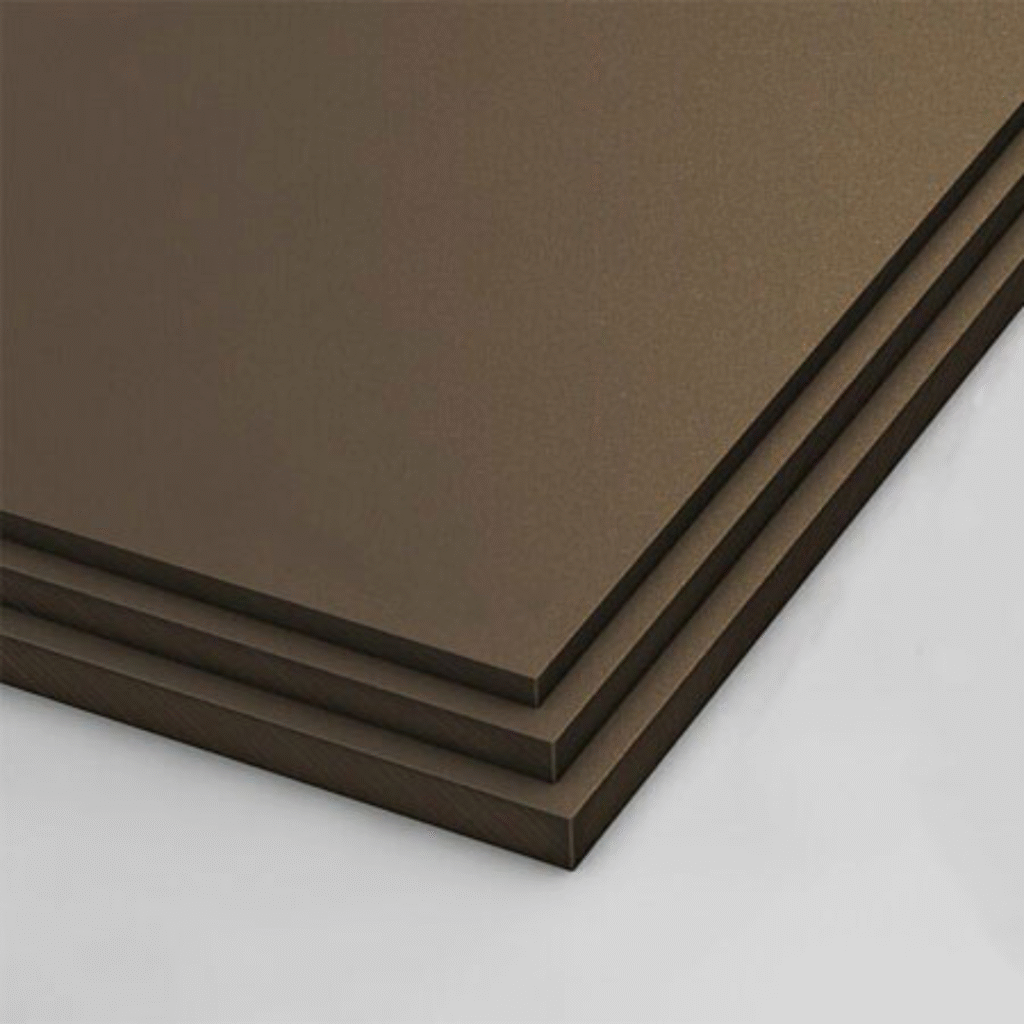Bronze-Filled PTFE
Bronze-filled PTFE is a high-performance composite material where PTFE (Polytetrafluoroethylene), a fine bronze powder, is combined. PTFE by itself is a very non-stick, very chemically resistant, and very low-friction surface. It is not that hard and can wear down under heavy loads.
Major Features of PTFE

Durability and Long Lifespan

High-Temperature Resistance

Non-Stick Properties

Electrical Insulation
The Bronze Filled PTFE is produced by mixing bronze powder (from 40% to 60%) in the PTFE resin. It is then moulded or extruded into its desired shape, which can be used. Sheets, rods, tubes, gaskets, valve components, and washers can be used as the things they are.
Adding bronze, an alloy that is mainly made of copper, makes it a much stronger and more durable material that still offers some of the benefits of PTFE. Bronze-filled PTFE has been successfully used in industrial applications where friction, pressure and heat need to be handled with minimal wear and tear.
The strength of the material improves, the dimensions stabilize, and loads are resisted by the bronze. PTFE maintains both a low friction, smooth surface and resistance to heat and chemicals.
By understanding the key strengths and limitations of this material, engineers and designers can choose it wisely.
Strengths
- Greater Mechanical Strength: The presence of bronze makes PTFE much more suitable for strength under load.
- Good Wear Resistance: This material can work continuously in high-friction conditions without deteriorating rapidly.
- Friction Level: Slightly higher than pure PTFE, but not high enough to prevent smooth motion between parts.
- Good High Thermal Stability: Will hold form and performance to 260°C (500°C).
- Pressure: The material is stable in shape, allowing parts not to change over time.
- Not Ideal in Moist Environments: Bronze is susceptible to corrosion and is not ideal in moist environments for extended periods.
- Less Chemical Resistance than Pure PTFE: While Bronze Filled PTFE is still resistant to most chemicals, it may not be suitable for very corrosive environments where strong acids and alkalis can affect it.
- Reduced Slipperiness: The bronze makes the surface slightly less smooth than pure PTFE, although it still provides excellent sliding properties.
Here is a simplified table outlining the common characteristics of Bronze-Filled PTFE:
Property | Details |
Bronze Content | Typically 40% to 60% by weight |
Color | Brown to golden, depending on the bronze ratio |
Temperature Resistance | Up to 260°C (500°F) |
Friction Level | Low (higher than pure PTFE, but still suitable for sliding parts) |
Hardness | Higher than virgin PTFE |
Tensile Strength | Significantly increased due to the bronze |
Chemical Resistance | Moderate to high; not ideal for strong acids |
Wear Resistance | Excellent under high load and motion |
Typical Applications Across Industries
Bronze-filled PTFE is balanced between strength and low friction in many critical applications in various sectors.
- Automotive: Strength and movement together in braking systems, suspension components, bushings, and piston rings.
- Aerospace Industry: Best for moving components within an aircraft that is subjected to high temperatures and pressure changes (e.g., bearings, seals).
- Food Processing Equipment: This material is approved for use in grades in that it has a nonreactive surface, which is suitable for continuous operation.
- Oil and Gas Sector: Used in seals, valve seats, and pump components in high-pressure high high-temperature conditions.
- Press Machine Cylinders: Common in small areas of machinery where friction reduction and wear resistance are critical, such as press machines, injection moulds, conveyor systems, rotating machinery, and other machinery.
- Electrical Industry: It is appropriate for the insulation of parts that have to withstand thermal stress and mechanical stress.
Design Considerations & Material Variability
Several factors should be considered when selecting Bronze-Filled PTFE for a particular application.
- Bronze Content: Higher bronze levels improve strength, lower self-lubricating properties. Lower content has lower structural support and more of PTFE’s slipperiness.
- Operating Environment: Formulation or use of materials may be different, depending on exposure to moisture, chemicals, or extremely high loads.
- Shape and Dimensions: The material can be supplied in the form of rods, sheets, tubes, and custom moulded parts. Depending on the requirements of the mechanical and dimensional format, choose the right one.
- Machinability: Bronze Filled PTFE is machinable using standard metal working tools, which provide the ability to have the part customised or precision in design.
Why Choose Hindustan Polymer Bronze-Filled PTFE?
Bronze-filled PTFE products are available from Hindustan Polymer, a reliable source of high-quality products. That’s why we are trusted by customers across industries.
- Raw Materials: Our raw materials come from carefully sourced high-grade material, also to meet industry standards for strength, durability, and consistency.
- Customization Possible: Whether it’s a non-standard size, a unique shape, or specific performance criteria, Hindustan Polymer can manufacture to your exact needs.
- Material Selection Expertise: An Experienced technical team that can help with material selection when dealing with industrial applications.
- Efficient Logistics & Inventory: Orders are fulfilled speedily with no long wait times and fast turns.
- Excellent Value for Money: We provide value for money without compromising on the quality or performance.
FAQS on Bronze-Filled PTFE
Bronze-filled PTFE displays high compressed power and reduces deformation under the load, making it suitable for applications associated with significant mechanical stress. Its dimensional stability ensures reliable performance in a dynamic environment.
Bronze-filled PTFE retains good chemical resistance; in addition to bronze, virgin PTFE can reduce its inaction compared to PTFE. It is less suitable for highly corrosive environments, so compatibility with specific chemicals should be assessed.
Bronze-filled PTFE has reduced chemical resistance and non-stick properties compared to virgin PTFE. Additionally, its increased density may not be suitable for weight-sensitive applications. Cost ideas should also be taken into consideration.
Bronze-filled PTFE provides better thermal conductivity and compressed power, making it ideal for high-load applications. In contrast, carbon-filled PTFE provides better chemical resistance and low friction, suitable for applications where these properties are preferred.
Yes, Bronze-filled PTFE maintains stability and performance at high temperatures, usually up to 260 ° C (500 ° F). Its increased thermal conductivity aids in heat disruptions, making it ideal for high temperature applications.
Related Bronze-Filled PTFE Materials
Bronze Filled PTFE is varied and has many product types available, ranging from task-specific.

Bronze-Filled Valve Sheet
Our Bronze Filled Valve Sheets are flat soft panels to provide sealing in the industrial valve systems. Because they are quite good in wear resistance and strength, they can stand high pressure, high temperature, with low leak time over a period.

Bronze-Filled Washer
The Bronze-Filled Washers we use between fastening surfaces reduce friction, reduce load, and stabilise. High durability under mechanical stress makes these washers ideal for use in rotating or vibrating assemblies of very heavy-duty machinery.

Bronze-Filled Sheet
Bronze-filled sheets are big flat panels that have wear resistance and thermal stability. They are most commonly used for surface lining or are shaped to a specific profile for use as components exposed to movement, pressure or temperature variation.

Bronze-Filled Rods
Our Bronze-Filled Rods are solid cylindrical profiles suitable for machining to bushings, spacers, seals, and other uses. They have good load-bearing capacity and dimensional stability and give very good results in continuous motion or load-bearing environments.

Bronze-Filled Gasket
Our Bronze Filled Gaskets are designed to seal the joint in piping systems, machinery housings, and process vessels. High pressure, heat, and mechanical stress are no problem for these gaskets, and they provide leak-free performance over the many years they are used in tough industrial settings.
